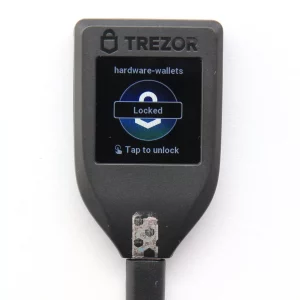What is a Taproot wallet? A Taproot wallet is a type of Bitcoin wallet that utilizes the Taproot protocol upgrade. Taproot represents a major upgrade to Bitcoin’s scripting capabilities, a significant step for Bitcoin since 2017’s SegWit. This upgrade brings several advantages, including enhanced privacy, scalability, and efficiency for your Bitcoin transactions. It enhances the functionality of the Lightning Network as well.
What is a Taproot wallet address and Taproot address example?
A Taproot wallet address is similar to a traditional Bitcoin address, but leverages the Taproot protocol. It begins with “bc1” and is followed by a series of characters.
When you use a Taproot compatible wallets for sending and receiving transactions, you’ll receive a unique Taproot address. These addresses, also known as Bech32m addresses, typically start with “bc1p”. For instance, an example Taproot address might look like “bc1pqqqqqqqqqqqqqqqqqqqqqqqqqqqqqqqqqqqpqqqq”.
How does Taproot work? Can I send BTC to a Taproot address?
Taproot utilizes Schnorr signatures and Merkelized Alternative Script Trees (MAST) to improve Bitcoin. This enhances privacy.
Taproot works by combining multiple potential spending conditions into a single Merkel root (a key component in securing the blockchain), with only the spending path being revealed upon use. This enables more complex scripts to appear as simple payment addresses to enhance privacy. Transactions involving complex features like multisig (where multiple parties authorize a spend) become indistinguishable from standard transactions. Additionally, sending BTC to a Taproot address is just like sending it to any other Bitcoin address. However, for full utilization of Taproot’s benefits, both the sender and recipient need to support Taproot transactions.
Benefits of Taproot
The Taproot protocol upgrade offers Bitcoin users the following benefits:
- Increased privacy for complex transactions
- Improved functionality of the Lightning Network
- Smaller transaction sizes, leading to lower fees
- More efficient use of blockchain space
- Opens doors for future Bitcoin applications
Disadvantages of Taproot
However, there are potential downsides, such as the following:
- Requires a Taproot-enabled wallet (not all wallets support it yet)
- The added complexity might be intimidating for new users
Taproot vs SegWit Address
Taproot and Segregated Witness (SegWit) are both upgrades to Bitcoin’s protocol, but they serve different purposes. While SegWit, a Bitcoin upgrade from 2017, primarily aims to increase transaction capacity and reduce fees by separating transaction signatures from transaction data, Taproot, implemented in 2021, focuses more on privacy, efficiency, and smart contract capabilities.
Find out more: Taproot vs SegWit Explained
How Do I Get a Taproot Wallet?
Firstly, many popular mobile, desktop, and web Bitcoin wallets now support Taproot, allowing you to either create a new Taproot wallet or enable Taproot in an existing one. Alternatively, you can use a hardware wallet that supports Taproot. Ensure your wallet software is up-to-date by installing the latest version, as Taproot support is typically included in recent updates. Follow the instructions to set up Taproot, and generate a new Taproot address for Bitcoin transactions.
Best Taproot Bitcoin Wallets
If you’re looking for a Taproot Bitcoin wallet, these are options for mobile wallets, desktop wallets, hardware wallets, and web wallets that support Taproot address:
Taproot Mobile Wallets
- Exodus
- Phoenix
- Muun
- Aqua Wallet
- Wallet of Satoshi
- Samourai
- Nunchuk
- Zeus Wallet
- Blixt Wallet
- Blockstream Green (Taproot multisig wallet)
- Fully Noded
Taproot Desktop Wallets
Taproot Web Wallets
Taproot Hardware Wallets
Exchanges Supporting Taproot Address
- AgoraDesk
- Peach Bitcoin
- Bitnob
- Bitaroo
- Binance
- Bull Bitcoin
- CoinCorner
- River Financial
- Strike
- Swan
- Cash App
- OkCoin
- Bitstamp
Payment Processors Supporting Taproot
Is Taproot good for Bitcoin?
Taproot brings significant advancements to Bitcoin, particularly in the area of user privacy. By making single and multi-signature transactions indistinguishable, it strengthens user anonymity on the network. There is a slight drawback, however, as Taproot transactions tend to be larger than those using Native SegWit, potentially leading to higher fees. However, Taproot’s efficiency gains in smart contracts can potentially offset this cost increase in the long run. This efficiency extends to complex smart contracts, which can now be built on the Bitcoin network using fewer resources.
While there’s a learning curve for new users, the benefits outweigh the drawbacks, making Taproot wallets a solid choice for those seeking a more private and efficient Bitcoin experience. Its adoption is expected to bring positive changes to the Bitcoin ecosystem, although widespread implementation and education are crucial for maximizing its benefits.



























